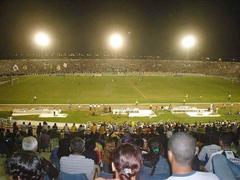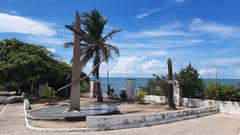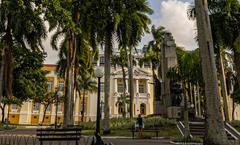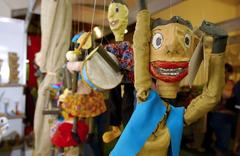
Palácio da Redenção: Visiting Hours, Tickets, and Tourist Guide in João Pessoa, Brazil
Date: 04/07/2025
Introduction: History and Cultural Significance
Nestled in João Pessoa’s historic center, the Palácio da Redenção stands as a testament to Brazil’s colonial past, political evolution, and enduring cultural identity. Established in 1586 by Jesuit missionaries as part of a religious-educational complex, the building has adapted across centuries—from ecclesiastical use to its long-standing role as the seat of Paraíba’s state government. The palace’s very name, “Redenção” (“Redemption”), honors the abolition of slavery and embodies the city’s aspirations for freedom and progress.
Now undergoing a transformative restoration to become the Museu da História da Paraíba, Palácio da Redenção is poised to welcome visitors with immersive exhibitions, digital resources, and interactive programming. Whether you’re seeking practical details on visiting hours and tickets, or keen to understand its architectural and political importance, this guide brings together everything you need for a rewarding visit. For the latest updates, refer to official resources such as IPHAEP and the João Pessoa City Hall tourism page.
Table of Contents
- Discover Palácio da Redenção: Why Visit?
- Colonial Foundations and Early Construction
- Architectural Evolution and Restoration
- Visiting Hours, Tickets, and Accessibility
- Political and Social Legacy
- Cultural Heritage and Collections
- The Palace’s Urban and Civic Context
- Travel Tips and Nearby Attractions
- Frequently Asked Questions (FAQs)
- Transformation into Museu da História da Paraíba
- Museum Highlights and Digital Initiatives
- Visitor Essentials: Location, Facilities, and Planning
- Final Recommendations and References
Discover Palácio da Redenção: Why Visit?
Located at the heart of João Pessoa, Palácio da Redenção is a premier destination for history, architecture, and culture enthusiasts. Visitors are drawn not only to its storied halls but also to its striking blend of colonial, neoclassical, and imperial styles, set amid tranquil French-inspired gardens. The palace’s central role in Paraíba’s political and social history makes it an essential stop for anyone exploring João Pessoa’s heritage.
Colonial Foundations and Early Construction
Palácio da Redenção is among João Pessoa’s oldest extant structures, originally serving as a Jesuit college and religious center (Paraíba Turismo). The Jesuits’ architectural style emphasized simplicity, durability, and function—thick masonry walls, modest facades, and small windows—reflecting their educational and missionary aims.
After the Jesuits’ expulsion in 1759, the building transitioned to various public uses before becoming the official residence and seat of Paraíba’s governors. This evolution marks a shift from religious to civic importance, mirroring changes in Brazil’s colonial and republican history.
Architectural Evolution and Restoration
Successive renovations have enriched the palace’s aesthetic, harmonizing colonial origins with neoclassical features—arched windows, ornate columns, and decorative cornices—especially prominent from the late 19th century onward (Governo da Paraíba). The gardens, established after the demolition of the Igreja de Nossa Senhora da Conceição in 1929, complement the building’s grandeur.
A major restoration in the 1980s preserved original elements while updating the structure for public use. Ongoing works, with investments exceeding R$ 10 million, are preparing the palace for its new life as the Museu da História da Paraíba (suplan.pb.gov.br).
Visiting Hours, Tickets, and Accessibility
- Current Hours: Monday–Thursday, 14:00–18:00; Friday mornings only (guiadasemana.com.br). Hours may expand after the museum’s inauguration (expected August 2025).
- Admission: Free; special exhibits may require tickets.
- Guided Tours: Available by advance booking; check with the João Pessoa tourism office for language options and scheduling (Bahia.ws).
- Accessibility: Recent upgrades include ramps, elevators, and adapted restrooms (clickpb.com.br).
- Facilities: Restrooms available; future plans include a café, gift shop, and educational spaces.
Political and Social Legacy
For over two centuries, Palácio da Redenção has been the heart of Paraíba’s political life, witnessing pivotal events from the proclamation of the Republic to the 1930 Revolution (História do Palácio da Redenção). The palace’s name, proposed by poet Rita Miranda in 1931, reflects a spirit of renewal and social transformation, especially in commemorating the abolition of slavery and the rise of João Pessoa as a national figure.
Cultural Heritage and Collections
The palace is an officially protected heritage site under IPHAEP (IPHAEP). Its interiors display portraits of former governors, period furnishings, and archival materials. Notably, the Memorial de 30 in the gardens houses the remains of Governor João Pessoa, underscoring the building’s symbolic status (pt.wikipedia.org).
The Palace’s Urban and Civic Context
Strategically positioned near the Legislative Assembly and the Court of Justice, Palácio da Redenção anchors João Pessoa’s historic center (Bahia.ws). The surrounding area is rich with other attractions, including the Santa Roza Theatre, São Francisco Church and Convent, and Praça Antenor Navarro, making it ideal for a day of cultural exploration (wildtrips.net).
Travel Tips and Nearby Attractions
- Getting There: Located at Praça João Pessoa, Centro; easily reached by taxi, bus, or on foot from most hotels.
- Best Time to Visit: Late afternoon on weekdays for fewer crowds and softer light.
- Recommended Duration: 1.5–2 hours to fully explore the palace, gardens, and nearby sites.
- Photography: Permitted in gardens and most public areas. Restrictions may apply indoors or during official events.
- Nearby: Santa Roza Theatre, São Francisco Church, artisan markets, cafés, and cultural venues (The Tourist Checklist).
Frequently Asked Questions (FAQs)
Q: Is there an entrance fee?
A: Admission is free, though special exhibitions may require tickets.
Q: What are the visiting hours?
A: Monday–Thursday, 14:00–18:00; Friday mornings. Hours may change after the museum opens.
Q: Is the palace accessible for people with disabilities?
A: Yes, recent renovations provide ramps, elevators, and adapted restrooms.
Q: Are guided tours available in English?
A: Most tours are in Portuguese; English/Spanish may be offered upon request.
Q: Can I visit the gardens without entering the palace?
A: Yes, the French-style gardens are open to the public.
Transformation into Museu da História da Paraíba
A landmark project is converting Palácio da Redenção into the Museu da História da Paraíba, with a vision for digital, participatory, and educational engagement (g1.globo.com). Restoration efforts led by Suplan focus on structural repairs, climate control, digital infrastructure, and the preservation of original features.
A highlight will be the controversial display of original floor tiles bearing swastika motifs—historic symbols that predate Nazi appropriation—accompanied by contextual interpretation (extrapb.com.br).
Planned museum features include:
- Interactive and virtual exhibits
- Digitized archives
- Educational workshops
- Community events and temporary exhibitions
The palace will retain ceremonial state functions, ensuring continuity with its political legacy.
Visitor Essentials: Location, Facilities, and Planning
Address: Praça João Pessoa, s/n, Centro, João Pessoa – PB, 58013-900, Brazil
Hours: Monday–Thursday, 14:00–18:00; Friday mornings; expanded hours expected post-museum opening
Entry: Free (guided tours should be booked in advance)
Contact: João Pessoa Cultural Foundation (FUNJOPE), tourism office, or official website
Accessibility: Ramps, elevators, and adapted restrooms
Facilities: Restrooms on-site; planned café, shop, and educational spaces
Final Recommendations
Palácio da Redenção is much more than a government building—it is a living repository of João Pessoa’s history, reflecting colonial origins, political milestones, and ongoing cultural evolution. The transformation into the Museu da História da Paraíba promises to deepen public engagement through innovative exhibits and community programming. Free access, proximity to other landmarks, and enhanced visitor amenities make this site a must-visit for anyone interested in Brazilian heritage.
For the latest visiting hours, ticketing updates, and event schedules, consult the João Pessoa tourism website and Suplan. Enhance your experience with the Audiala app, offering guided tours, interactive maps, and insider content.




